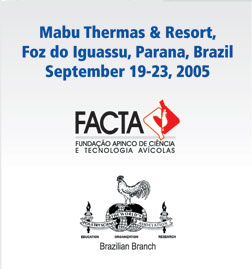Contributed Papers: Oral Presentations
Molecular biology and Biochemistry |
The developmental
expression of Eimeria Heat shock protein 90
Miska, K.B., Lillehoj, H.S., Fetterer,
R.H.
USDA/ARS, Animal Parasitic Diseases Laboratory
10300 Baltimore Ave, Beltsville, MD 20705 U.S.A
Heat shock protein
90 (Hsp90) represents one of the most abundant and
evolutionarily conserved proteins. Because in most
species studied Hsp90 was found to be essential for
proper cell function, a study investigating Eimeria
Hsp90 was initiated.The full-length Eimeria acervulina
and Eimeria maxima Hsp90 cDNAs were isolated and sequenced.
From evolutionary analysis and sequence identity,
it is likely that the Eimeria Hsp90 sequences described
so far encode the cytosolic versions of the protein.
Although at nucleotide and amino acid level Eimeria
Hsp90s are highly similar, their expression profiles
differ considerably. The E. acervulina Hsp90 transcripts
are developmentally regulated, with little or no expression
in developing and in fully sporulated oocysts. The
analysis of Hsp90 protein in E. acervulina corroborates
with RT-PCR data, which show that the highest protein
levels are expressed by sporozoites and merozoites,
with little or no expression in oocysts. While E.
tenella and E. maxima Hsp90 transcripts were present
in every stage tested, the level of expression differed
among stages. The mRNA expression profile was very
similar to the protein expression, with the highest
amounts of protein expressed in sporozoites and merozoites.
We have also observed that E. tenella Hsp90 is not
actively secreted by sporozoites or merozoites. The
significance of differential Hsp90 expression profiles
in these species is currently unknown; however, it
is clear that the molecular mechanisms occurring during
oocyst development may be quite different between
Eimeria.
